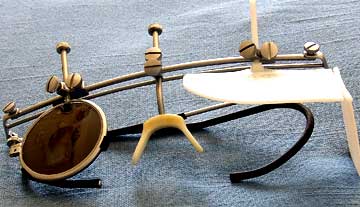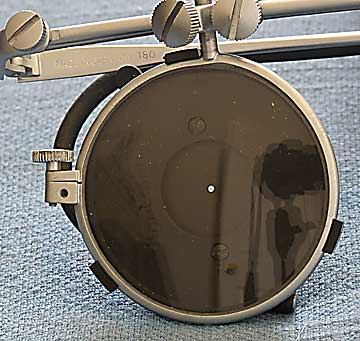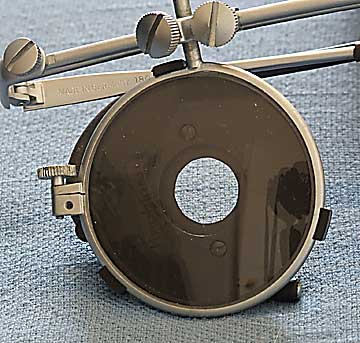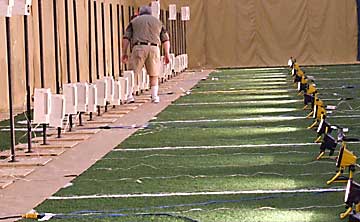by B.B. Pelletier
Today’s topic was raised by a casual comment I made last week about shooting glasses making the front sight sharper. Rabbitt asked for an explanation and then one or two others chimed in with interest, so I thought I’d share with all of you this well-publicized “secret” to better shooting. The kind of glasses I’m talking about today are not for eye protection, though they do that as well. Their primary purpose is to help you see the front sight and target when shooting a target gun. Glasses are used by both rifle and pistol competitors, and even by archers, but since I know pistol glasses much better, they are what I will describe today.
What do they do?
Shooting glasses contain one lens for the master eye, and if you have a corrective prescription, that lens can be ground for you. But not all shooters need correction. Therefore, a master eye lens can also be clear glass. You see, vision correction is only one thing the glasses do. The other major benefit is that they allow the shooter to adjust his own eyes, overriding the automatic light-controlling iris in the eyeball. That’s where the real magic happens.
Adjusting your iris?
Shooting glasses contain an adjustable iris over the master eyepiece that lets the shooter adjust to the light on the range. The lower the light, the more open you have to make the iris to see the target well. In case you hadn’t noticed, lighting on a shooting range is controlled so that a lot of light falls on the target, with relatively less anywhere else.

Shooting glasses have an extremely adjustable frame on which all manner of optical shooting aids can be mounted. White blinder on the right (on left when glasses are worn) flips up for better vision when not shooting.

Iris on master eye adjusts from small…

…to very large.

Part of the target line at the 2007 NRA/Pyramyd AIR National Junior Airgun Championships. There is a halogen light in front of each position.
This light is then received by the eye, but when a stooter looks at a wide enough angle, like 200 feet, or so, so much light overpowers the eye, causing it to adjust down to a pinpoint opening for protection. The adjustable iris on the master eye of the shooting glasses lets you select only the light falling on your own target, so your master eye pupil can open wide. That does something remarkable. The iris on your shooting glasses then acts like the adjustable iris in the lens of a camera, while forcing your own eye to assume the properties of a very fast film. You photographers know what happens when you stop a lens down to a very small aperture. You get incredible depth of field. Objects both near and far are in focus! The “speed” of your eye keeps things stay in focus in real time (you don’t have to stare at them a long time to see the image).
The miracle of shooting glasses!
They let you see both the front sight and the bullseye in sharp focus at the same time! Even the rear sight is in relatively sharp focus. You cannot usually accomplish this without shooting glasses, though how you light the range does help a lot.
What else do shooting glasses do?
You’ll notice that the other eye has no lens at all. It is covered by a plastic blinder, or shade that blocks light from the front and side. That allows the shooter to keep that eye open without seeing anything distracting. The master eye becomes stronger because it’s the only eye that works. The result is a sharp image of the front sight…and the target is nearly as sharp. This increases the precision of your aim a great deal. The blinder can be lifted easily when you need depth of vision for walking or even loading your gun.
I use Knoblock glasses – one of several brands with similar features. As you can see, they are incredibly adjustable to fit your face perfectly. My glasses cost about $110 ten years ago. Then, I had to have the master eye lens made. I thought that might be a real pain, but when I went to Lenscrafters in the mall, the doctors and on-site lab knew all about shooting glasses. Apparently, every large community has hundreds of shooters asking for the same thing. It was easy for them to grind my lens to fit the frame and my prescription. That was another $100. Everything else (the final adjustment of the glasses) was up to me.
Cannot compete without them
Shooting glasses are worth at least 10 points in a match, so you absolutely cannot compete without them. You might be able to make do at a local level, but when you get up against real shooters at the regional and state level, you need every trick in the book to win. Just as I have seen people shooting Daisy 777s in regional matches, I have also seen plenty of shooters without shooting glasses. None of them ever won, though.
BB
great post, very informative.
Before reading this, i thought that shooting glasses were nothing other than gimmicks to make you look like a nerd lol.
Now, i will even consider getting a pair.
Thing is though, they still make you like like a nerd 🙁
Yes, they do make you look like a nerd, but an armed nerd!
B.B.
BB,
Does this (blinder on the left eye) help a left eye dominant shooter shoot pistol right handed?
My son is left eye but right handed. I am alos wondering for archery for him.
KTK
KTK,
In my opinion it will help. You can conduct an experiment by covering his safety glasses with paper the next time he shoots.
B.B.
I know that the accepted approach is that the front sight must be in-focus, but for me it worked better if I could see the target better (at least at 100 to 600 yards). I suspect that the real point is to maintain one’s mental focus on the front sight.
The iris helps in many situations but if one tries to get both the target and front sight in-focus, the iris becomes so small that the light getting through is too low — again, a compromise must be reached with either the front sight or the target or somewhere in-between being in-focus.
I would not say that conventional wisdom is wrong, just that it might not be right for everyone and it does not hurt to try various solutions to see what works best for the individual.
“Just as I have seen people shooting Daisy 777s in regional matches, I have also seen plenty of shooters without shooting glasses. None of them ever won, though.”
Does the “never won” comment apply just to the glasses, or to the Daisy as well?
The issues of eye dominance and “handedness” keep arising. Here is my experience.
I am now mid-60’s. Even with toy guns, I held a rifle left-handed but a handgun with my right hand. Unfortunately, my feet were often not coordinated with my arms, so my feet would be positioned for shooting right-handed, but my arms for left-handed shooting. This is a difficulty that many ambidextrous people have, and it makes wing shooting and “practical” handgun shooting difficult. Target shooting is easier.
Neither eye is dominant, both when I test and also according to optometrists. When 8-10 years old my left eye had better near vision and my right eye better far vision; I saw the front sight and target better with my right eye. [ that is still somewhat true, but my ability to focus is much diminished, even with correction ].
I might hold the rifle or shotgun against my left shoulder, but with feet positioned for right-handed shooting, and then use my right eye for seeing the sight and target.
Since most weapons are designed to use right-handed and since vision was better with my right eye, I decided to shoot right-handed, and practiced coordinating my feet and arms–although that issue never totally disappeared. I also partially close my left-eye to not confuse sighting but allow light to enter.
No easy solution for ambidextrous shooter and those with eye dominance issues.
Farmer
Was looking at Lyman’s web page for front sight inserts and see that they list a “shooters eyeglass diopter” which uses a suction cup to attach the aperture to glasses. I remember reading about such apertures in the “American rifleman” –before it became a political journal. Here is the link:
http://www.lymanproducts.com/lymanproducts/index.htm
Farmer
Vince,
I meant the 777.
B.B.
Farmer,
I sympathize. I don’t know what I’d do in that situation.
B.B.
Farmer,
I almost included these low-cost solutions in my report. They actually do work to a limited degree.
B.B.
Vince,
its not that the 777 in not accurate. Its the fact that the 3000$ Feinwerkbau 700 is more accurate.
-sumo
That plus the fact that pistols and rifles seldom compete in the same match.
B.B.
same concept.
-sumo
I knew one guy who stuck a piece of black electrical tape with a small hole melted in it on his right eyeglass lens. It wasn’t against the rules.
Cheap and easy to try.
twotalon,
A guy in my 10-meter league actually did something similar to that. But positioning the hole proved too great a problem, so he broke down and bought shooting glasses.
B.B.
sorry about yesterday bb
Is the gamo r-77 combat a good pistol, I mean would I
be able to shoot magpies with it (I don’t know if they have magpies stateside, similar size and toughness to a crow)and get a clean kill, I am looking at this to use instead of my .22 short
thank you
Trapshooter
Trapshooter,
Specifically, no on the R77. It’s a low-velocity gun that cannot take the magpies humanely.
B.B.
Trapshooter, a .22 short has about 70 ft-lbs of energy. An R77 has on the order of 2 to 3 ft-lbs. You might be better off, if noise is your concern, using a CCI CB round, they still do about 30ft-lbs of energy.
I can’t imagine this being a reliable crow gun, although I’m certainly open to correction if I’m wrong.
BB,
Can these shooting glasses be effective in shooting with scoped rifles?
David
thank you bb and vince
what would be a suitable pistol to use on them?
I don’t know air guns to well and this blog has been of infinite help in my choices
thank you
Trapshooter
I also like the more realistic looking air pistols and that was what attracted me to the gamo
Trapshooter
Silencers
I know that in most states its difficult for you guys to use silencers, but i hope BB can answer this anyway. Many (but not all) silencers for air guns and firearms contain what is little more that a series of springs lightly tensioned. I would like to know what these springs actually do? I have tried removing them, and the gun is louder, but i cant logically think how they work?
Thanks
Paul
Many thanks BB.
Sorry I got here late but it looks like this one was of interest to many people.
Great explanation. I think you covered all my questions. Guess I’m going to have to go see my optop, optham, oh heck, my eye doc for some shooting glasses.
Rabbitt
BB,
I is the 707s harmonics so loud becaue the barrel and tank are connected loke thay are?
-sumo
David,
The would be no advantage to using shooting glasses with a scope because the scope flattens the reticle and target already. In other words, there is no need to focus on the front sight.
Also, I doubt that it’s even possible to use shooting glasses when looking through a scope. The whole idea of a scope is a large exit pupil for best light transmission, while shooting glasses cut the light that passes to the master eye – just the opposite.
B.B.
Trapshooter,
The Evanix AR6 pistol would be ideal, but may have more power than you desire.
A Beeman P1/Weihrauch HW 45 might also work if the shot is under 25 yards.
The cheapest gun to use would be a Crosman 2240.
B.B.
Paul,
What do springs do? They provide energy, or in the case of a silencer, absorb it. Energy in the exhaust gasses or air of a gun is what makes the noise. Getting rid of it makes the exhaust quieter.
The gasses have to move the spring and that robs them of energy.
B.B.
sumo,
I don’t really know why the 707 is so loud. But I do know that the tanker carbine with a free-floated barrel that’s not connected to the tank is just as loud, though it doesn’t have that unusual after “ring” that a straight 707 has.
B.B.
This all leaves out the most important need for wearing shooting glasses, any why they are helpful even when looking through a scope.
Shooting glasses, allow the wearer to adjust the position of the lens.
When you look straight (on axis) through the center of a lens, there is no distortion. As you look at greater angles, or through a part other than the center, distortion increases (at different rates, depending on the lens type/system, but this is true for any level of magnification not equal to 1).
With shooting glasses, you can adjust a prescription lens to be in the correct position, EVEN WHEN USING A SCOPE. Its very unlikely to be looking straight through the optical center of regular glasses, with your cheek on a rifle stock (or even in most pistol stances).
On a rifle, I tend to look through the far upper left hand corner of normal glasses, and with a pistol, I look through the right of the lens. Both of these positions cause the dot in my holosights to appear to be fuzzy and oval (distortion on the target is just as real, but harder to see or describe).
With shooting glasses, I can correct for this, and get a perfectly clear pinpoint dot.
I see this post has not been updated since 2007! With regard to the gentleman's comment "Was looking at Lyman's web page for front sight inserts and see that they list a "shooters eyeglass diopter" which uses a suction cup to attach the aperture to glasses. I remember reading about such apertures in the "American rifleman" –before it became a political journal. Here is the link:
http://www.lymanproducts.com/lymanproducts/index.htm" , actual link to the product he describes in case anyone is interested is now http://www.lymanproducts.com/lyman/sights/hawkeye.php
Jeff,
Thanks for the updated information. When you post a comment you only have to do it one time. We don't allow comments to be posted to this blog until they are screened by a moderator, because we get a lot of spammers.
B.B.